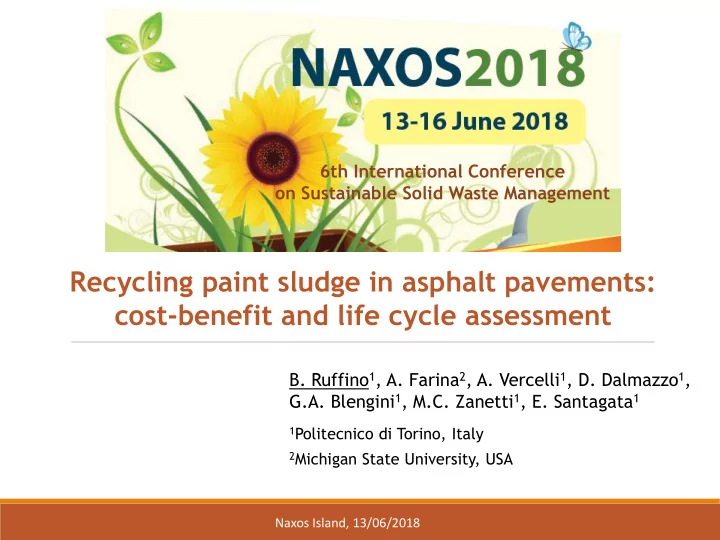

6th International Conference on Sustainable Solid Waste Management Recycling paint sludge in asphalt pavements: cost-benefit and life cycle assessment B. Ruffino 1 , A. Farina 2 , A. Vercelli 1 , D. Dalmazzo 1 , G.A. Blengini 1 , M.C. Zanetti 1 , E. Santagata 1 1 Politecnico di Torino, Italy 2 Michigan State University, USA Naxos Island, 13/06/2018
Paint sludge Waste product generated during automotive painting, when the overspray is captured by air flows and collected with water. TS VS C H N Fe Al Ti Sample (%) (%) (%) (%) (%) (%) (%) (%) Primer 0.9 0.5 8.3 57 ± 22 61 ± 7 ND ND ND (3) ± 1.4 ± 0.2 ± 3.6 Basecoat 6.4 3.0 0.5 2.1 7.4 40 ± 9 73 ± 8 48 ± 6 (6) ± 0.8 ± 1.4 ± 0.2 ± 0.9 ± 3.1 Clearcoat 8.1 7.5 0.2 1.0 < 35 ± 11 95 ± 1 60 ± 2 (3) ± 0.1 ± 0.8 ± 0.2 ± 0.6 0.05 B. Ruffino et al., Recycling paint sludge in asphalt pavements: cost-benefit and life cycle assessment
Recycling of Paint Sludge in Asphalt Pavements Materials and Structures (2017) Demonstration at a lab scale of the feasibility of using paint sludge in mixtures for asphalt pavements Field test, November 2016 Traditional binder Paint sludge modified binder (1) Paint sludge modified binder (2) B. Ruffino et al., Recycling paint sludge in asphalt pavements: cost-benefit and life cycle assessment
Cost Benefit Assessment ASPHALT DEWATERING MIXING WITH CONCRETE & MILLING BITUMEN PREPARATION A focus on the cost-benefit assessment procedure INPUT DATA M = 3,000 t/y TS = 35-40% t = 250 d/y, 24 h/d Adapted from Ruffino et al., 2014 – Waste Manage 34 (2014), 148-155 B. Ruffino et al., Recycling paint sludge in asphalt pavements: cost-benefit and life cycle assessment
Cost Benefit Assessment ASPHALT DEWATERING MIXING WITH CONCRETE & MILLING BITUMEN PREPARATION 95 € /t 49 € /t 144 € /t treatment cost neat bitumen cost 450 € /t Amount of sludge in bitumen 10% 3.7∙10 6 m 2 Amount of binder in HMC 5.5% Hot mix concrete density 2.3 kg/dm 3 Thickness of the wearing course 3 cm Road wideness 6 m B. Ruffino et al., Recycling paint sludge in asphalt pavements: cost-benefit and life cycle assessment
Life Cycle Assessment «from cradle to gate» Quarry for Paint sludge aggregates • SimaPro software generation and treatment • Comparison of 2 scenarios Production of traditional HMA 20 km • energy 7 km Production of HMA with modified binder (20% paint sludge in the 10 km Asphalt binder) concrete plant • electricity Incinerator • fuel 350 km Refinery Bitumen production B. Ruffino et al., Recycling paint sludge in asphalt pavements: cost-benefit and life cycle assessment
Life Cycle Assessment «from cradle to gate, scenario 1» Quarry for Paint sludge aggregates • SimaPro software generation and disposal • Comparison of 2 scenarios Production of traditional HMA 20 km Production of HMA with modified binder 10 km Asphalt concrete plant • electricity Incinerator • fuel 350 km Refinery Bitumen production B. Ruffino et al., Recycling paint sludge in asphalt pavements: cost-benefit and life cycle assessment
Life Cycle Assessment «from cradle to gate, scenario 2» Quarry for Paint sludge aggregates • SimaPro software generation and treatment • Comparison of 2 scenarios Production of traditional HMA 20 km • energy 7 km Production of HMA with modified binder 10 km Asphalt concrete plant • electricity Incinerator - 20% • fuel 350 km Refinery Bitumen production B. Ruffino et al., Recycling paint sludge in asphalt pavements: cost-benefit and life cycle assessment
Life Cycle Assessment GER, Gross Energy Requirement (MJ/kg) 16% 2.67 3.18 GWP, Global Warming Potential (gCO 2 eq/kg) 40% 52.6 31.7 B. Ruffino et al., Recycling paint sludge in asphalt pavements: cost-benefit and life cycle assessment
Conclusions • The generation of paint sludge (PS) in Italian plants is in the order of 3 kg/car on a wet basis (FCA, 2016). Reuse of paint sludge as a substitute of a part of the conventional binder for • the production of concrete for asphalt pavements was proposed and the technical feasibility of the process was successfully demonstrated (Dalmazzo et al., 2017). The unit cost of treatment, that includes the operations of dewatering and • milling and mixing PS with neat bitumen, was of 144 € /t. • The economic balance was positive, because a PS treated at a cost of 144 € /t could substitute up to 20% of neat bitumen (at a cost of 450 € /t) in a binder used for asphalt concrete production without worsening the performances of the pavement. The LCA analysis revealed that the production of a hot mix asphalt by • employing a bitumen with the addition of 20% (w/w) PS, reduced the Gross Energy Requirement (GER) by approximately 16% respect to the traditional process. The Global Warming Potential (GWP) index decreased from 52.6 to 31.7 g • CO 2 eq/kg asphalt mixture. B. Ruffino et al., Recycling paint sludge in asphalt pavements: cost-benefit and life cycle assessment
6th International Conference on Sustainable Solid Waste Management Thanks for your kind attention! B. Ruffino 1 , A. Farina 2 , A. Vercelli 1 , D. Dalmazzo 1 , G.A. Blengini 1 , M.C. Zanetti 1 , E. Santagata 1 1 Politecnico di Torino, Italy 2 Michigan State University, USA Correspondence to: barbara.ruffino@polito.it B. Ruffino et al., Recycling paint sludge in asphalt pavements: cost-benefit and life cycle assessment
Recommend
More recommend